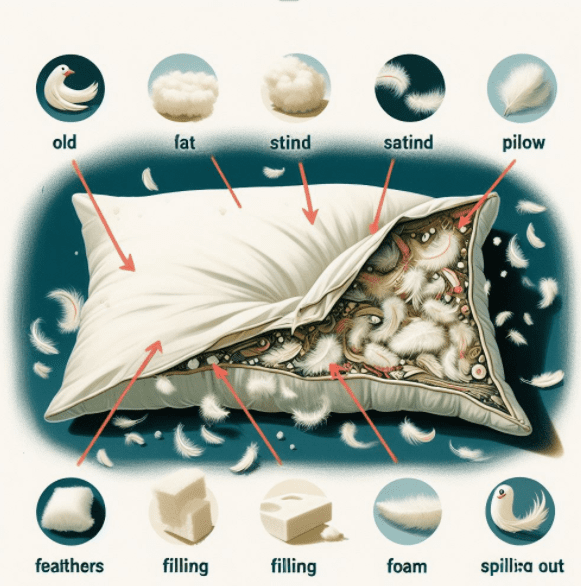
Are you waking up with aches, allergies, or feeling generally unrested? The culprit might be your pillow. Find out how often you should replace your pillow and the benefits of a fresh one. Imagine sinking into a luxurious hotel bed with impossibly fluffy, cloud-like pillows. That blissful feeling is why fresh pillows can be magical.
Now, take a hard look at your pillow. If it resembles a sad pancake, it could rob you of quality sleep, leave you stiff muscles, or even trigger stubborn allergies. Studies show that up to 40% of people experience neck pain due to unsupportive pillows. It’s time to give your pillow a serious checkup!
Why Replacing Your Pillow Matters (More Than You Think)
- Hygiene Havoc: Your pillow isn’t as innocent as it looks. It collects dust mites, sweat, dead skin cells, and other microscopic nasties each night. The average pillow contains thousands of dust mites and their droppings – a major trigger for allergy sufferers and a general ick factor no one needs in their bed.
- Support = Sweet Dreams: Over time, even the best pillows lose their loft and resilience. This lack of support throws your head and neck out of alignment, causing aches, pains, and restless nights.
- Weird Lumps and Bumps: If your pillow is filled with feathers or synthetic fibers, you might notice unevenness or clumping. These disrupt comfort and prevent the pillow from properly cradling your head.
Pillow Lifespans
| Pillow Type | Typical Lifespan | Notes | Best For |
|---|---|---|---|
| Down/Feather | 1-3 years | Prone to clumping, hygiene issues | Allergy sufferers may want to steer clear |
| Synthetic | 18-36 months | Affordable but offer less support over time | Budget-conscious shoppers, guest rooms |
| Memory Foam | 2-3 years | Can retain heat, check for breakdown or indentations | Those who want pressure relief, contouring |
| Buckwheat/Specialty | Varies | Look for manufacturer guidelines | Can be noisy, but adjustable loft is a plus |
Your Pillow is Begging for Replacement If…
- The Fold Test Fails: Fold your pillow in half. It loses its supportive power if it doesn’t spring back immediately.
- Neck Pain is Your Morning Routine: A flat pillow misaligns your spine during sleep, leading to soreness and stiffness.
- Allergy Attacks at Night: If you sneeze and congested, your old pillow is likely a haven for allergens.
- It Smells Funky: Even with washing, pillows can develop a lingering odor – a sure sign it’s time for a replacement.
Pillow TLC
- Washable Wonders: Follow care instructions on the tag precisely. Some pillows need delicate cycles, while others can handle more vigorous washing.
- Pillow Protectors are Your BFF: An easy-to-wash barrier against sweat, spills, and allergens creates a cleaner and longer-lasting pillow.
- Sunbathing for Sweetness: Sunlight is a natural sanitizer. Give your pillow a few hours of sun every few months (if its material allows) to kill bacteria and freshen it up.
- Spot Cleaning SOS: Accidents happen! A mix of mild dish soap and water is often effective for spot-cleaning small stains.
Expert Opinion
“Choosing the right pillow is just as important as choosing a good mattress. Improper spinal alignment during sleep can cause a cascade of problems throughout your day.” – Dr. Sarah Marshall, Chiropractor.
Ditch and Switch
- Eco-Conscious Disposal: Look up textile recycling facilities in your area, or repurpose old pillows as cozy pet beds.
- Sleepy Style Guide: Side sleepers need firmer pillows for neck support, back sleepers do best with medium firmness, and stomach sleepers benefit from the softest options.
FAQ
-
Can washing my pillow extend its lifespan?
Absolutely! Regular washing removes allergens, sweat, and oils that can break down pillow materials. However, following the care instructions precisely is essential to avoid damaging the pillow.
-
Are expensive pillows always better?
Not necessarily. While premium materials and construction often translate to greater durability and support, excellent, budget-friendly options exist. Focus on your individual needs (sleep position, allergies, etc.) rather than just the price tag.
-
What’s the difference between hypoallergenic and allergy-proof pillows?
Hypoallergenic pillows use materials less likely to trigger allergies. Allergy-proof pillows have tightly woven covers that block allergens like dust mites from entering in the first place.
-
I have neck pain – is there a specific pillow type I should use?
While consulting a chiropractor is best, side sleepers typically need firmer, higher-loft pillows. Back sleepers do well with medium support, and stomach sleepers need softer, thinner pillows to minimize neck strain.
-
How many pillows should I sleep with?
This is mainly personal preference. However, sleeping with too many pillows can misalign your spine. Start with one high-quality pillow, and add a second only if it improves your comfort without compromising alignment.
Conclusion
A quality pillow is a worthwhile investment in your health and well-being. Don’t underestimate the power of a fresh, supportive pillow to revolutionize your sleep. Sweet dreams!




























